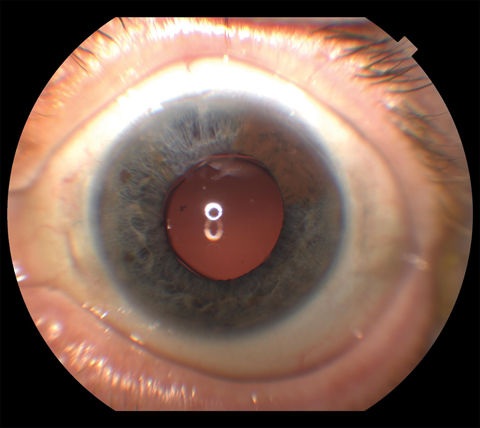Transscleral fixation technique may reduce intraoperative IOL placement time
Click Here to Manage Email Alerts
A transscleral fixation technique using a foldable posterior chamber IOL and 25-gauge pars plana vitrectomy may improve anatomic and visual outcomes while minimizing the risk of complications and reducing surgical times, according to a study.
“The technique achieves the implantation of a posterior chamber IOL through a small incision in the absence of capsular support, which is applicable to a wide range of patients, whether aphakic, pseudophakic with IOL subluxation or dislocation, and/or dislocated cataract or cataract fragments,” study author Daniel A. Adelberg, MD, told Ocular Surgery News.
Existing techniques have been associated with increased surgical time because of the greater technical complexity and a higher risk of complications such as choroidal hemorrhage, retinal detachment, suture erosion or lysis. The transscleral fixation technique attempts to reduce the complexity of surgical decision-making and reduce the difficult intraocular maneuvers of other approaches, Adelberg said.
The retrospective chart review evaluated 77 consecutive patients who underwent this modified external approach.
Technique
First, the cornea is marked in the periphery of the horizontal meridian at two points that are 180° apart, and a conjunctival peritomy is made adjacent to both marks. A scleral flap is developed at the 3 o’clock and 9 o’clock positions.


Images: Adelberg DA






Next, 25-gauge microcannulas are placed 2 mm posterior to the limbus 4 mm apart, creating four sclerotomies, two temporally and two nasally.
A complete 25-gauge vitrectomy is performed with a fifth intrusion cannula and utilizing one of the nasal and temporal sclerotomies.
An ab externo pass of a 9-0 polypropylene suture without needle is made through temporal cannula No. 1 into the posterior chamber with 25-gauge microforceps and removed through the limbal incision with a second set of 25-gauge microforceps before being passed through both eyelets on the temporal haptic of the posterior chamber IOL, passed through the limbal incision, and externalized through the temporal cannula No. 2. The procedure is then repeated for the nasal sclerotomies.
The IOL is inserted and unfolded in the posterior chamber. For optimum centration, the temporal and nasal sutures are tightened and adjusted before they are tied permanently.
“After the 9-0 polypropylene suture has been placed on one side of the eye through each cannula and both eyelets on one side of the IOL and externalized, the cannulas can be removed followed by a temporary knot created to reduce suture tangle or inadvertent traction on the suture or IOL when the contralateral suture placement maneuvers are performed,” Adelberg said.
After the correct IOL centration is verified and sutures permanently tied, the scleral flaps are closed, covering the polypropylene knot usually without additional sutures, and 4 mg of triamcinolone acetonide is injected into the vitreous. Lastly, the conjunctiva and limbal incisions are sutured.
Posterior chamber IOL
In this technique, Adelberg uses the Akreos AO60 foldable posterior chamber IOL (Bausch + Lomb) with stable four-point transscleral fixation because the IOL has four eyelets for suture placement, the foldable design allows a smaller, more stable incision with less potential for induced astigmatism, and the aspheric design allows for advanced optics, he said.
“The four-point fixation of the [posterior chamber] IOL is advantageous as it reduces the possibility of torsion or tilt of the fixated IOL, as a two-point fixation could rotate as in a hammock,” he said. “The Akreos AO60 IOL facilitates this as it has a unique haptic design with four small closed eyelets for suture placement without the need for additional suture knots or suture slippage.”
Learning curve
In the first 40 cases of the series, mean operating time was 56 minutes, and in the second round of cases, the mean operating time was reduced to 45 minutes.
Adelberg partially attributed the reduced operating time to innovations in surgical tools.
“The corneal refractive marker accurately places the microcannulas, which will ultimately determine the centration of the IOL; an IOL folding forceps eases IOL folding prior to implantation; and the short-curved 25-gauge forceps reduces difficulty of suture placement and retrieval, especially from the nasal cannulas,” he said.
Adelberg recommended working with specialty counterparts to learn this technique and to prepare for the low-rate and long-term complications associated with it.
“If you are an anterior segment surgeon, consider performing surgery initially with a vitreoretinal colleague, and if you are a vitreoretinal specialist, consider performing surgery initially with an anterior segment colleague,” he said. – by Kristie L. Kahl
- Reference:
- Wallmann AC, et al. J Cataract Refract Surg. 2015;doi:10.1016/j.jcrs.2015.09.005.
- For more information:
- Daniel A. Adelberg, MD, can be reached at Southwestern Eye Center, 2610 East University Drive, Mesa, AZ 85213; email: adelberg@sweye.com.
Disclosure: Adelberg reports he is a consultant for Valeant Pharmaceuticals.
